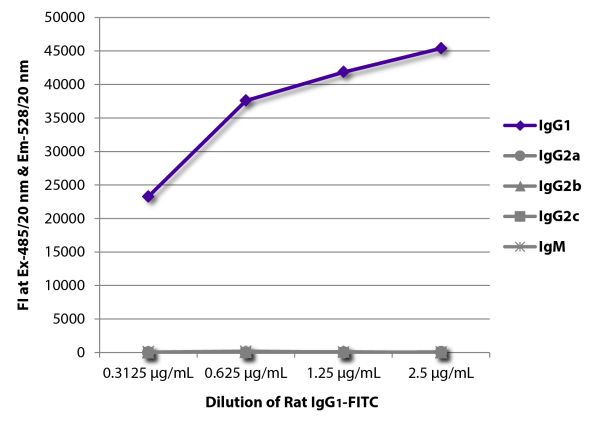Quimigen Portugal > Rat IgG1-FITC
Rat IgG1-FITC
Marca : Southern Biotech
Solicitar mais informações
Por favor, faça login para usar este recurso.
Rat IgG1-FITC (KLH/G1-2-2)
Cat. No.:
0116-02
Rat IgG1-FITC for use as a control in flow cytometry and immunocytochemistry assays.

FLISA plate was coated with Mouse Anti-Rat IgG1-UNLB (SB Cat. No. 3061-01), Mouse Anti-Rat IgG2a-UNLB (SB Cat. No. 3065-01), Mouse Anti-Rat IgG2b-UNLB (SB Cat. No. 3070-01), Mouse Anti-Rat IgG2c-UNLB (SB Cat. No

| Clone | KLH/G1-2-2 |
|---|---|
| Isotype | Rat IgG1κ |
| Specificity | KLH |
| Conjugate | FITC (Fluorescein) |
| Buffer Formulation | Phosphate buffered saline containing < 0.1% sodium azide |
| Clonality | Monoclonal |
| Concentration | 0.5 mg/mL |
| Volume | 1.0 mL |
| Recommended Storage | 2-8°C; Avoid exposure to light |
| Applications | Flow Cytometry – Quality tested 1-3 ELISA – Quality tested FLISA – Quality tested Immunocytochemistry – Reported in literature 3,4 Blocking – Reported in literature 5 In vitro Control – Reported in literature 6-8 In vivo Control – Reported in literature 8-14 |
| RRID Number | AB_2793980 |
Documentation
Technical Bulletin Safety Datasheet
Certificate of Analysis Lookup
Enter the Catalog Number and Lot Number for the Certificate of Analysis you wish to view
UNLB AP HRP BIOT PE APC SPRD LE/AF PE/CY7 APC/CY5.5 APC/CY7 PACBLU AF488 AF647
- 1. Chu VT, Fröhlich A, Steinhauser G, Scheel T, Roch T, Fillatreau S, et al. Eosinophils are required for the maintenance of plasma cells in the bone marrow. Nat Immunol. 2011;12:151-60. (FC)
- 2. Berge T, Grønningsæter IH, Lorvik KB, Abrahamsen G, Granum S, Sundvold-Gjerstad V, et al. SH2D2A modulates T cell mediated protection to a B cell derived tumor in transgenic mice. PLoS One. 2012;7(10):e48239. (FC)
- 3. Gaspar-Elsas MI, Queto T, Vasconcelos Z, Jones CP, Lannes-Vieira J, Xavier-Elsas P. Evidence for a regulatory role of α4-integrins in the maturation of eosinophils generated from the bone marrow in the presence of dexamethasone. Clin Exp Allergy. 2009;39:1187-98. (FC, ICC)
- 4. Chu VT, Berek C . Immunization induces activation of bone marrow eosinophils required for plasma cell survival. Eur J Immunol. 2012;42:130-7. (ICC)
- 5. Talkington J, Nickell SP. Role of Fc gamma receptors in triggering host cell activation and cytokine release by Borrelia burgdorferi. Infect Immun. 2001;69:413-9. (Block)
- 6. Lopez JI, Camenisch TD, Stevens MV, Sands BJ, McDonald J, Schroeder JA. CD44 attenuates metastatic invasion during breast cancer progression. Cancer Res. 2005;65:6755-63. (In vitro control)
- 7. Lee S, Choi H, Eun S, Fukuyama S, Croft M. Nitric oxide modulates TGF-β-directive signals to suppress Foxp3+ regulatory T cell differentiation and potentiate Th1 development. J Immunol. 2011;186:6972-80. (In vitro control)
- 8. Brouxhon SM, Kyrkanides S, Teng X, Raja V, O'Banion MK, Clarke R, et al. Monoclonal antibody against the ectodomain of E-cadherin (DECMA-1) suppresses breast carcinogenesis: involvement of the HER/PI3K/Akt/mTOR and IAP pathways. Clin Cancer Res. 2013;19:3234-46. (In vitro control, in vivo control)
- 9. Haeryfar SM, DiPaolo RJ, Tscharke DC, Bennink JR, Yewdell JW. Regulatory T cells suppress CD8+ T cell responses induced by direct priming and cross-priming and moderate immunodominance disparities. J Immunol. 2005;174:3344-51. (In vivo control)
- 10. Liang Y, Christopher K, Finn PW, Colson YL, Perkins DL. Graft produced interleukin-6 functions as a danger signal and promotes rejection after transplantation. Transplantation. 2007;84:771-7. (In vivo control)
- 11. Dakhama A, Lee Y, Ohnishi H, Jing X, Balhorn A, Takeda K, et al. Virus-specific IgE enhances airway responsiveness on reinfection with respiratory syncytial virus in newborn mice. J Allergy Clin Immunol. 2009;123:138-45. (In vivo control)
- 12. Zhang Z, Li Z, Yan S, Wang X, Abecassis M. TNF-α signaling is not required for in vivo transcriptional reactivation of latent murine cytomegalovirus. Transplantation. 2009;88:640-5. (In vivo control)
- 13. Saha S, Jing X, Park SY, Wang S, Li X, Gupta D. Peptidoglycan recognition proteins protect mice from experimental colitis by promoting normal gut flora and preventing induction of interferon-γ. Cell Host Microbe. 2010;8:147-62. (In vivo control)
- 14. Brouxhon SM, Kyrkanides S, Raja V, Silberfeld A, Teng X, Trochesset D, et al. Ectodomain-specific E-cadherin antibody suppresses skin SCC growth and reduces tumor grade: a multitargeted therapy modulating RTKs and the PTEN-p53-MDM2 axis. Mol Cancer Ther. 2014;13:1791-802. (In vivo control)




